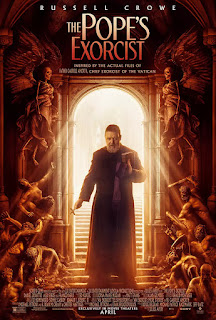Still, viewers interested in the true story of Father Gabriele Amorth, who claimed to have performed tens of thousands of exorcisms during his 30-year career as the Vatican’s head exorcist, will be left wanting. The Pope’s Exorcist attempts to do for Amorth what The Conjuring franchise did for Ed and Lorraine Warren, but despite an excellent production design and efficient direction under Julius Avery, it isn’t nearly scary enough to work on those terms.
The Pope’s Exorcist stars Russell Crowe as Amorth in a commanding central performance that injects some offbeat humor into an otherwise serious persona (“the Devil doesn’t like jokes,” he tells his unwitting assistant). Savoring a robust Italian accent like a fine wine, Crowe’s Amorth is always an interesting screen presence even when the story dives into the predictable.
Early scenes of The Pope’s Exorcist depict some promising insight into Amorth’s background. The film opens with an exorcism in rural Italy, 1986, as the Father tricks a demon into escaping a young man and possessing a pig; the beast is quickly slaughtered, killing the demon with it.
Before a Vatican tribunal, however, Amorth reveals that, in fact, he knew that the young man was not possessed: that he was suffering from some kind of psychosis, and a little theater might have been what was needed to save him. In fact, the Father reveals, 98 percent of the possessions he is dispatched to investigate are actually mental health issues.
This story thread is nicely conveyed through flashbacks that circle around Amorth’s greatest regret: a young woman who feigned possession who he referred to psychiatrists. She later committed suicide after failing to receive the help she needed.
Of course, The Pope’s Exorcist is not an exposé on exorcisms conducted by the Catholic church. It focuses on the purported two percent of possessions Amorth dealt with that turned out to be the real deal, and during the events of the movie involve a young American boy (Peter DeSouza-Feighoney) who becomes possessed after moving with his mother (Alex Essoe) and sister (Laurel Marsden) to a sprawling abbey in rural Spain.
Like nearly every movie of this type that been released over the past 50 years in the wake of The Exorcist, the possession scenes in The Pope’s Exorcist involve a child wearing heavy prosthetic makeup effects tied to a bed, levitating objects and bodies thrown around the room, a foul-mouthed demon, and priests holding crosses and reciting prayers. Ralph Ineson fills in for Mercedes McCambridge as the voice of the demon.
The Exorcist understood that it wasn’t the physical manifestation of the demon that was scary: it was the suggestion that such great and unknown evil could even exist in the world that sent shivers down our spines. Five decades later, The Exorcist remains one of the scariest movies ever made; The Pope’s Exorcist doesn’t even attempt to work on that level.
Instead, the narrative leans into tropes from Japanese horror rather than possession movies. In order to save the young boy and vanquish the demon, Amorth and his assistant (Daniel Zovatto) must solve the mystery that lies underneath the abbey, which involves dark secrets from the Spanish Inquisition.



0 Comments